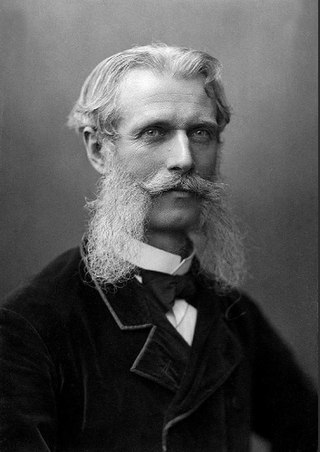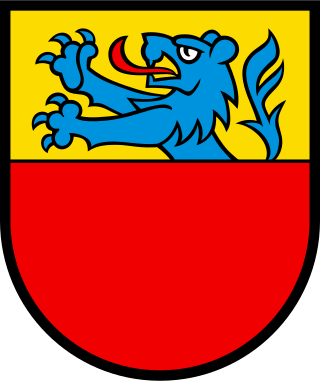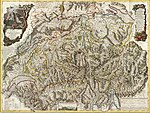
Bern, or Berne, is the de facto capital of Switzerland, referred to as the "federal city". With a population of about 133,000, Bern is the fifth-most populous city in Switzerland, behind Zürich, Geneva, Basel and Lausanne. The Bern agglomeration, which includes 36 municipalities, had a population of 406,900 in 2014. The metropolitan area had a population of 660,000 in 2000.

Basel-Landschaft or Basel-Country, informally known as Baselland or Baselbiet, is one of the 26 cantons forming the Swiss Confederation. It is composed of five districts and its capital city is Liestal. It is traditionally considered a "half-canton", the other half being Basel-Stadt, its urban counterpart.

Carl Andreas Hilty was a Swiss lawyer, professor of constitutional law, politician, philosopher, lay theologian and writer.

Valerius Anshelm, born as Valerius Rüd, was a Swiss chronicler working in Bern.

The Historical Dictionary of Switzerland is an encyclopedia on the history of Switzerland. It aims to present the history of Switzerland in the form of an encyclopaedia, published both on paper and on the internet, in three of the country's national languages: German, French and Italian. When it was completed at the end of 2014, the paper version contained around 36,000 articles divided into thirteen volumes. At the same time, a reduced edition of the dictionary has been published in Romansh under the title Lexicon istoric retic (LIR), and constitutes the first specialist dictionary in the Rhaeto-Romance, Switzerland.

Englisberg is a village in the district of Seftigen in Canton Bern, Switzerland. On January 1, 2004, the independent municipality merged with Zimmerwald to form the new municipality of Wald BE. Situated on the Längenberg, above the valley of the Aare river, it combines the villages of Englisberg and Kühlewil. Englisberg is first documented in 1166 [Endlisperc]. It is believed that Englisberg was created out of the much older village of Kühlewil [Cullenwil, Cullenwilare - originally of Celtic origin] the latter of which having since attained the status of a hamlet of the former. In the 14th century a castle is documented in Englisberg, owned by the family of the same name. It was abandoned by the following 15th century and quickly fell into disrepair and disintegration. The feudal rights over Englisberg were acquired by the von Erlach family of Bern in 1433 and passed in 1542 to the Baumgartner family of the same place. After 1570, these feudal rights were sold to local farming families Guggisberg and Zimmermann which over the course of several generations were split into 70 shares. In the 18th century, these rights were successively purchased by the aristocratic von Graffenried and von Tscharner families seated at the Lohn estate in Kehrsatz only to lose it all when Switzerland was invaded by the French in 1798 that resulted in the abolishment of the ancient order. Englisberg belonged until 1798 to the high court district of Seftigen. Ecclesiastically Englisberg was part of the evangelical reformed parish church of neighboring Belp till 1699 and thereafter was integrated into the newly created parish of Zimmerwald.

The city of Bern is one of the Zähringer foundations of the late 12th century. By the end of the 13th century, it had acquired de facto imperial immediacy. It became a full member of the Old Swiss Confederacy in 1353, and during the 15th century managed to significantly expand its sphere of influence, notably with the conquest of Aargau in 1415. With the acquisition of Vaud in 1536, Bern became the most powerful city-republic north of the Alps, and one of the leading Protestant cities in early modern Switzerland. The canton of Bern in the Restored Confederacy of 1815 even after the loss of Aargau and Vaud remained the largest Swiss canton, relegated to second rank only with the secession of Jura in 1979. Since 1848 Bern has served as the federal city (capital) of Switzerland.

The Old City is the medieval city center of Bern, Switzerland. Built on a narrow hill bordered on three sides by the river Aare, its compact layout has remained essentially unchanged since its construction during the twelfth to the fifteenth century. Despite a major fire in 1405, after which much of the city was rebuilt in sandstone, and substantial construction efforts in the eighteenth century, Bern's old city has retained its medieval character.

The Gerechtigkeitsgasse is one of the principal streets in the Old City of Bern, the medieval city center of Bern, Switzerland. Together with its extension, the Kramgasse, it is the heart of the inner city. Hans Gieng's most famous fountain figure, the statue of Lady Justice on the Gerechtigkeitsbrunnen, commands the view of the street's gentle slopes and curves.
The construction and operation of Swiss railways during the 19th century was carried out by private railways. The first internal line was a 16 km line opened from Zürich to Baden in 1847. By 1860 railways connected western and northeastern Switzerland. The first Alpine railway to be opened was under the Gotthard Pass in 1882. A second alpine line was opened under the Simplon Pass in 1906.

The Münstergasse is one of the streets in the Old City of Bern, the medieval city center of Bern, Switzerland. It is part of the Zähringerstadt which was built during the foundation of the old city in 1191. However, until 1967 it was parts of several other streets. It runs along the cathedral and it is part of the UNESCO Cultural World Heritage Site that encompasses the Old City.

Franz Rudolf Frisching was a Swiss nobleman, military officer, politician and industrialist.
The following is a timeline of the history of the municipality of Zürich, Switzerland.
The following is a timeline of the history of the city of Basel.
The following is a timeline of the history of the city of Rostock, Germany.
Annie Leuch-Reineck was a Swiss mathematician and women's rights activist. She was one of the most influential participants in the Swiss women's movement during the 1920s and 1930s.
The history of the Jews in Bern dates back to at least the Middle Ages. Following the expulsion and persecution of Jews during and after the Black Death epidemic, few Jews were able to live or work in the canton until the 19th century. The Jewish community of Bern was founded in 1948 and is active to this day.

Samuel Engel was a Swiss librarian, civil servant, economist and agronomist working in Bern who introduced innovations in several fields. He was convinced of the existence of a Northeast Passage and published several influential books about the Arctic.

John Burnaby (1701–1774) was a British diplomat. He was Resident minister to the Swiss cantons.













